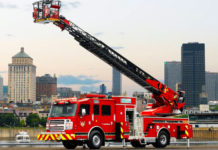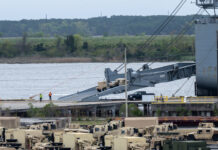The National Oceanic and Atmospheric Administration (NOAA) was able to successfully use six Raytheon Company Coyote® unmanned aerial vehicles (UAVs) to track and model Hurricane Maria.
Launched from a NOAA WP-3D Orion hurricane hunter aircraft, the Coyotes flew directly into the storm, giving researchers an unprecedented view of Maria from a safe distance.
(See launches of Coyote and Silver Fox unmanned aircraft systems from every angle. Courtesy of Raytheon and YouTube)
Developed for the military, Coyote is a small, expendable UAV that’s air- or ground-launched into environments too dangerous for manned aircraft. The system can fly for more than an hour and up to 50 miles from its host aircraft.

“Raytheon technology is enabling hurricane hunters to understand storm behavior in new and better ways,” said Dr. Thomas Bussing, Raytheon vice president of Advanced Missile Systems.
“Our expendable Coyote UAVs are delivering vital information about these potentially deadly storms—and that can help save lives.”
Navigating Maria’s winds of greater than 100 miles per hour, the Coyotes gathered and transmitted storm information directly to the National Hurricane Center.
(Learn More. Coyote, the unmanned aircraft can fly into very low and very turbulent parts of a hurricane that are too dangerous for piloted planes. Courtesy of WPRI and YouTube)
NOAA scientists are evaluating the data to better understand Hurricane Maria and other storms like it.

“NOAA is investing in these unmanned aircraft and other technologies to increase weather observations designed to improve the accuracy of our hurricane forecasts,” said Dr. Joe Cione, NOAA hurricane researcher and chief scientist for the Coyote program.
“The Coyotes collected critical, continuous observations in the lower part of the hurricane, an area impossible to reach with manned aircraft.”
Researchers can also fly Coyotes throughout the storms, revisiting key locations inside hurricanes to obtain the most robust data possible.
(Take a rare look inside NOAA’s P-3 Orion which flies directly into the eye of hurricanes. Courtesy of Fox News and YouTube)
The Coyote system is one of Raytheon’s family of high-tech weather forecasting technology, including:
- The Visible Infrared Imaging Radiometer Suite instrument aboard NOAA’s Suomi NPP spacecraft,
- The common ground system for the Joint Polar Satellite System, and
- The Advanced Weather Interactive Processing System, a powerful forecast toolkit that helps meteorologists make sense of the massive amounts of weather data that modern sensors collect.
 With a history of innovation spanning 95 years, Raytheon provides state-of-the-art electronics, mission systems integration, C5I™ products and services, sensing, effects, and mission support for customers in more than 80 countries.
With a history of innovation spanning 95 years, Raytheon provides state-of-the-art electronics, mission systems integration, C5I™ products and services, sensing, effects, and mission support for customers in more than 80 countries.
















